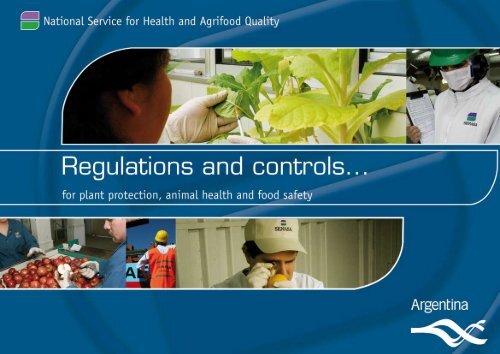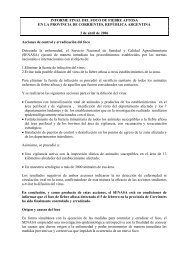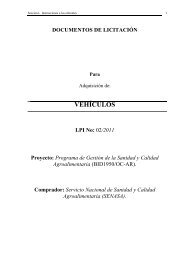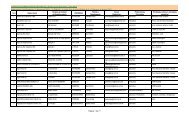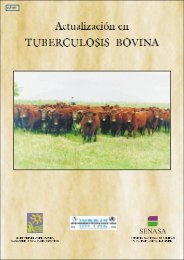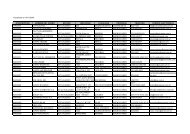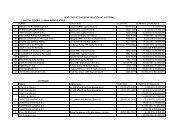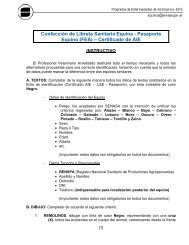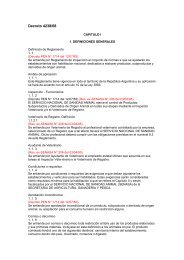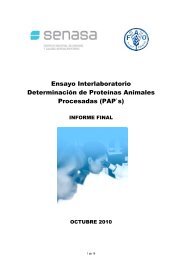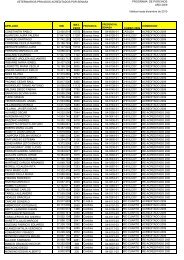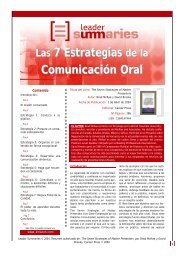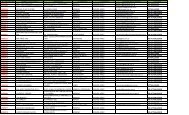Página - Senasa
Página - Senasa
Página - Senasa
You also want an ePaper? Increase the reach of your titles
YUMPU automatically turns print PDFs into web optimized ePapers that Google loves.
Página
Our Strategic Direction<br />
Institutional actions of the National Service for Agri-food Health and Quality (<strong>Senasa</strong>)<br />
are guided by a management model relying on science-based risk analysis and process<br />
control.<br />
Thus, <strong>Senasa</strong> offers scientifically validated safeguards and controls supported by<br />
accreditable documentation that guarantee the health and quality of farm products from<br />
the origin and throughout the entire value chain to consumers in domestic and foreign<br />
markets.<br />
This strategy strengthens the role of the State in the area of animal and plant health<br />
and food safety whilst taking into account the environmental impact of the activities it<br />
controls.<br />
Página<br />
2
Values, Vision and Mission<br />
The values we share<br />
Ethics, reliability, transparency, professionalism and competence, social commitment,<br />
equity, respect and recognition.<br />
The vision we share<br />
To be the national and international referent government agency for its reliability,<br />
technical capability and human values in preserving animal and plant health, including<br />
hygiene and safety of farm products, inputs and foodstuffs within its sphere of<br />
responsibility, working towards the general welfare with sustainable procedures.<br />
The vision we are committed to<br />
Planning, regulating, executing, overseeing and certifying processes and actions within<br />
a framework of programmes related to animal and plant health, including safety, hygiene<br />
and quality of foodstuffs, products and inputs, responding to national and international<br />
requirements and demands, emerging issues and trends in new scenarios.<br />
Página<br />
3
“Approximately 5000 highly<br />
qualified employees hold a broad<br />
range of scientific, technical and<br />
administrative positions at <strong>Senasa</strong>.”<br />
Página<br />
4
Who we are<br />
Established in 1995, <strong>Senasa</strong> is a<br />
decentralised body of the National<br />
Government that reports to the Secretariat<br />
of Agriculture, Livestock, Fisheries and<br />
Food (Sagpya) of the National Ministry<br />
of Production. <strong>Senasa</strong> is the agency<br />
responsible for executing national policies<br />
on animal health, plant protection and<br />
food safety.<br />
Our Service meets its institutional goals<br />
with 14 regional centres.<br />
The central level (National Directorates)<br />
issues rules on animal health, plant<br />
protection and food safety whereas the<br />
regional centres execute specific animal<br />
and plant health programmes and verify<br />
that participants in the agri-food chain<br />
conform to regulatory requirements.<br />
<strong>Senasa</strong> does not work alone. In coordination<br />
with provincial and municipal<br />
animal health and plant protection<br />
authorities, the Service ensures,<br />
with a national approach, continuous<br />
improvement of the sanitary and<br />
phytosanitary status, as required by local<br />
and global consumers.<br />
Our people<br />
Approximately 5000 highly qualified<br />
employees hold a broad range of<br />
scientific, technical and administrative<br />
positions at <strong>Senasa</strong>.<br />
The employees of the Service carry out<br />
their activities at <strong>Senasa</strong> headquarters,<br />
the regional centres and in the network of<br />
laboratories.<br />
Veterinarians, agronomists, technicians<br />
and veterinary assistants in the field,<br />
slaughterhouses, packing houses, ports,<br />
airports and borders, with the support of<br />
biologists and chemists in the laboratories<br />
and employees in administrative positions<br />
work towards one goal: to protect plants<br />
and animals from pests and diseases for<br />
Argentineans to eat healthy foods.<br />
To carry out this mandate and conform<br />
to the guidelines on animal and plant<br />
health and food safety established by the<br />
Argentine government, <strong>Senasa</strong> employees<br />
strive to:<br />
• Develop an efficient and effective<br />
regulatory framework and check that<br />
farmers, processors, truckers, distributors,<br />
as primary responsibles for the health,<br />
safety and hygiene of their products,<br />
conform to statutory requirements;<br />
• Safeguard the sustainability of animal<br />
and plant resources;<br />
• Ensure professional, respectful and<br />
transparent management.<br />
Página<br />
5
Página<br />
6
“For the employees of the Service to<br />
carry out their functions efficiently,<br />
as of 2004 <strong>Senasa</strong> has a Strategic<br />
Training Programme in place.”<br />
Precisely, for the employees of the Service<br />
to carry out their functions efficiently, as<br />
of 2004 <strong>Senasa</strong> has a Strategic Training<br />
Programme which provides professionals,<br />
technicians, veterinary assistants and<br />
administrative clerks the necessary tools<br />
to manage animal health programmes,<br />
analyse and define objectives and<br />
expected results, and include ethical and<br />
social responsibility criteria in the public<br />
service they perform.<br />
Leadership and Management Structure<br />
<strong>Senasa</strong> is managed by a President, a Vice<br />
President and a General Manager.<br />
The President is the legal representative<br />
of the Agency; responsibilities of the<br />
President include implementing current<br />
regulations within the scope of authority of<br />
the Service and defining, together with the<br />
Vice President, the policies and goals for<br />
the management level.<br />
The Vice President is also responsible<br />
for overseeing technical, legal and<br />
administrative issues and chairs <strong>Senasa</strong>’s<br />
Advisory Board.<br />
The General Manager is responsible for<br />
planning and guiding the activities to<br />
attain the expected results, as defined in<br />
the strategic objectives previously set by<br />
<strong>Senasa</strong>’s authorities.<br />
The Advisory Board, a nonbinding<br />
advisory body, is formed by<br />
representatives of farmer´s associations<br />
and the agri-food industry as well as<br />
rotating representatives from the five<br />
major production regions of Argentina<br />
(NOA, NEA, Nuevo Cuyo, Patagonia and<br />
Pampeana). The Board also represents<br />
<strong>Senasa</strong> employees.<br />
Página<br />
7
Página<br />
8<br />
“To implement and promote<br />
sanitary and phytosanitary<br />
actions and food safety within<br />
its sphere of authority, <strong>Senasa</strong><br />
issues regulations that ensure<br />
conformance to the Argentine<br />
Food Code and international<br />
statutes.”
What we do<br />
Maintain an Effective Regulatory<br />
Framework<br />
To implement and promote sanitary and<br />
phytosanitary actions and food safety,<br />
<strong>Senasa</strong> issues regulations that ensure<br />
conformance to the Argentine Food Code<br />
and international statutes. To this end,<br />
<strong>Senasa</strong> verifies that all participants in<br />
the agri-food chain conform to current<br />
regulations.<br />
To ensure a framework of sciencebased,<br />
effective and transparent national<br />
regulations, <strong>Senasa</strong> continuously<br />
reviews the statutes and participates in<br />
international fora where it actively cooperates<br />
in drafting animal and plant<br />
health legislation.<br />
Protect Plants and Animals in Argentina<br />
The health of farm products and food<br />
safety are the “heart” of <strong>Senasa</strong>.<br />
The Service works to ensure that<br />
products are healthy both for consumers<br />
in the country and in the foreign markets<br />
to which Argentina exports agri-food<br />
products.<br />
By protecting the health of plants and<br />
animals from pests and diseases, <strong>Senasa</strong><br />
agents make it possible for our population<br />
and millions of people around the world to<br />
eat safe, quality products.<br />
Inspect Farm Products and By-products<br />
At a national level, <strong>Senasa</strong> oversees<br />
that processing and manufacturing<br />
establishments, fishing vessels and<br />
storage facilities for edible and non-edible<br />
animal products, by-products and derived<br />
products conform to hygiene and sanitary<br />
regulations.<br />
Control of In-country Movements of<br />
Goods and Animals and our Borders<br />
<strong>Senasa</strong> is also responsible for checking<br />
in-country movements of goods and<br />
animals, imports and exports of animals<br />
and plants and their derived products,<br />
agri-foods, veterinary medicinal products,<br />
agrochemicals, fertilizers and soil<br />
amendments.<br />
With border controls, and strengthened<br />
surveillance and follow-up activities,<br />
<strong>Senasa</strong> is capable of rapidly detecting<br />
pathogenic agents that pose a risk to<br />
animal and plant health.<br />
Página<br />
9
Página<br />
10<br />
“Efficient achievement of the<br />
objectives set by <strong>Senasa</strong> requires<br />
having in-house capabilities<br />
to analyse the technical<br />
characteristics of products, drugs,<br />
containers, labels, inserts and<br />
brochures related to veterinary<br />
medicine, plant health and<br />
agricultural production.”
Prevent Transmission of Animal Diseases<br />
to Humans<br />
<strong>Senasa</strong> also works on preventing,<br />
eradicating and reducing the possible<br />
incidence of zoonoses (diseases<br />
transmitted by animals to humans such<br />
as, for example, Bovine Spongiform<br />
Encephalopathy, also known as Mad Cow<br />
Disease, and Avian Influenza).<br />
Likewise, <strong>Senasa</strong> is responsible for the<br />
surveillance of other diseases (Foot and<br />
Mouth Disease and Brucellosis, among<br />
others) together with provincial and<br />
municipal authorities and others working in<br />
animal health in Argentina.<br />
Certify Exports<br />
<strong>Senasa</strong> certifies the exports of plant<br />
products and their by-products, which are<br />
shipped to over 150 markets.<br />
In the last five years, <strong>Senasa</strong> certified an<br />
average of 20 billion US Dollars in agrifood<br />
products for export.<br />
Maintain a Network of Laboratories<br />
Efficient achievement of the objectives<br />
set by <strong>Senasa</strong> requires having in-house<br />
capabilities to analyse the technical<br />
characteristics of products, drugs,<br />
containers, labels, inserts and brochures<br />
related to veterinary medicine, plant health<br />
and agricultural production and to test for<br />
the presence of contaminants or residues<br />
in products, by-products and derived<br />
products of animal and plant origin.<br />
The network of laboratories has analytical<br />
capabilities to test microbiological,<br />
technological, chemical and physical<br />
characteristics of derived products<br />
of animal and plant origin. <strong>Senasa</strong> is<br />
responsible for approving, granting<br />
accreditation and overseeing diagnostic<br />
laboratories and antigen manufacturers<br />
which participate in the national network.<br />
<strong>Senasa</strong>’s network of laboratories is<br />
internationally recognised for its scientific<br />
reputation.<br />
Página<br />
11
Página<br />
12
Develop Animal and Plant Health<br />
Programmes<br />
The Service is responsible for planning,<br />
scheduling, organising, executing and<br />
overseeing surveillance, detection,<br />
prevention, control and eradication plans<br />
and programmes for plant pests and<br />
animal diseases.<br />
The surveillance and inspection<br />
programmes implemented by <strong>Senasa</strong><br />
focus on detecting risks to the health<br />
of animals and plants and their derived<br />
products. These programmes also<br />
propose and evaluate campaigns to<br />
eradicate animal diseases (infectious,<br />
parasitic and zoonótico diseases) and<br />
plant pests, particularly those requiring<br />
quarantine.<br />
The programmes also co-ordinate<br />
on-going research in endemic animal<br />
diseases and quarantine plant pests, and<br />
review applicable statutes.<br />
Register Agrochemicals, Pharmacological<br />
and Veterinary Products, and control their<br />
production<br />
With regard to agrochemicals and<br />
pharmacological and veterinary products,<br />
<strong>Senasa</strong> is responsible for developing and<br />
overseeing conformance to the rules and<br />
regulations on production, marketing and<br />
use of agrochemicals and biologicals used<br />
in agricultural production and trade and for<br />
pest control.<br />
Develop Two-way Communication<br />
As primary responsibles for animal<br />
health, plant protection and food safety,<br />
participants in the agri-food chain must be<br />
informed about a broad range of topics<br />
related to <strong>Senasa</strong>’s activities, particularly<br />
the regulations it issues.<br />
From this viewpoint, communication is,<br />
for <strong>Senasa</strong>, a management tool which<br />
facilitates dialogue and interaction with<br />
farmers, processors, truckers, distributors<br />
and consumers and the democratic<br />
commitment to transparency.<br />
As consumers also play a fundamental<br />
role in preserving food safety and to keep<br />
the population informed, <strong>Senasa</strong> posts<br />
information on safe practices for healthy<br />
food selection and handling of foodstuffs<br />
on its web page.<br />
Página<br />
13
Página<br />
14<br />
“Communication is, for <strong>Senasa</strong>, a<br />
management tool which facilitates<br />
dialogue and interaction with<br />
farmers, processors, truckers,<br />
distributors and consumers.”
Protect the Environment<br />
The environment is a common good<br />
of the entire community and as such<br />
should be preserved and supported by<br />
all citizens. To this end, <strong>Senasa</strong> works<br />
with participants in the agri-food chain to<br />
implement good agricultural practices and<br />
animal welfare principles.<br />
Thus, <strong>Senasa</strong> promotes sustainable<br />
development, responding to today’s needs<br />
without jeopardizing the capacity of future<br />
generations to respond to theirs.<br />
This publication is part of <strong>Senasa</strong><br />
communication with the agri-food<br />
chain and the community.<br />
For further information, contact us<br />
at:<br />
www.senasa.gov.ar<br />
info@senasa.gov.ar<br />
0800-999-2386<br />
Copyright <strong>Senasa</strong> – 2009<br />
Página<br />
15
Página


